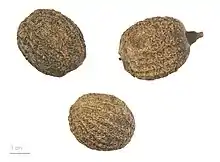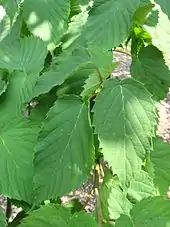| Davidia involucrata | |
|---|---|
 | |
| Scientific classification | |
| Kingdom: | Plantae |
| Clade: | Tracheophytes |
| Clade: | Angiosperms |
| Clade: | Eudicots |
| Clade: | Asterids |
| Order: | Cornales |
| Family: | Nyssaceae |
| Genus: | Davidia Baill. |
| Species: | D. involucrata |
| Binomial name | |
| Davidia involucrata | |
| Synonyms | |
|
Davidia laeta | |

Davidia involucrata, the dove-tree,[1] handkerchief tree, pocket handkerchief tree, or ghost tree, is a medium-sized deciduous tree in the family Nyssaceae.[2] It is the only living species in the genus Davidia. It was previously included with tupelos in the dogwood family, Cornaceae.[3] Fossil species are known extending into the Upper Cretaceous.
Taxonomy
Davidia involucrata is the only member of its genus, but there are two varieties differing slightly in their leaves, D. involucrata var. involucrata, which has the leaves thinly pubescent (short-haired) on the underside, and D. involucrata var. vilmoriniana, with glabrous (hairless) leaves.[4] Some botanists treat them as distinct species, with good reason, as the two taxa have differing chromosome numbers so are unable to produce fertile hybrid offspring.
Description
It is a moderately fast-growing tree, growing to 20–25 m (66–82 ft) in height, with toothed, alternate, ovate-cordate leaves resembling those of a linden, except that they are symmetrical, and lack the lop-sided base typical of linden leaves; the leaves are mostly 10–20 cm long and 7–15 cm wide.
Davidia involucrata is best known for its inflorescence that features large, white bracts surrounding a purplish-red flower head. The Latin specific epithet involucrata means "with a ring of bracts surrounding several flowers".[5] The true flowers form a tight head about 1–2 cm across, each flower head with a pair of large (12–25 cm), pure white bracts at the base, performing the function of petals in attracting pollinators. The inflorescences hang in long rows beneath the horizontal branches, and appear prolifically in late spring. On a breezy day, the bracts flutter in the wind like white doves or pinched handkerchiefs; hence the English names for this tree.
The fruit is a very hard nut about 3 cm long surrounded by a green husk about 4 cm long by 3 cm wide, hanging on a 10 cm stalk. The nut contains 3–6 seeds.
Distribution and habitat
Davidia involucrata is native to South Central and Southeast China. It grows in montane mixed forests.[6]
History
The genus Davidia is named for Father Armand David (1826–1900; "Père David"), a French Vincentian missionary and keen naturalist who lived in China. David first described the tree in 1869 as a single tree found at over 2,000 m (6,562 ft) altitude, and sent dried specimens to Paris; in 1871, Henri Baillon described it as a new genus and species.[7][8]
British plant hunter Augustine Henry again found a single tree, this time in the Yangtse Ichang gorges and sent the first specimen to Kew Gardens. Plant collector Ernest Henry Wilson was employed by Sir Harry Veitch to find Henry's tree but arrived to find that it had been felled for building purposes; however, he later found a grove of the trees overhanging a sheer drop.[9] Returning to Britain, Wilson’s boat was wrecked, but he managed to save his Davidia specimens,[10] one of which survives today in the Arnold Arboretum.[11]
Gallery
 Young tree in flower
Young tree in flower Form
Form Bark
Bark Leaves
Leaves
Fossil record
The oldest probable fossils of Davidia are permineralized fruits from the Upper Cretaceous (Campanian) Horseshoe Canyon Formation of Dinosaur Provincial Park near Drumheller, Alberta, Canada. Those fruits are smaller than those of D. involucrata and have fewer locules, but are otherwise similar in morphology to the extant genus.[12]
In 2009, B. I. Pavlyutkin described Miocene fossils in Primorsky Krai and assigned them to a new species in the genus Davidia.[13]
Cultivation
The species was introduced from China to Europe and North America in 1904, and is a popular ornamental tree in parks and larger gardens. Most trees in cultivation are var. vilmoriniana, which has proved much better able to adapt to the climatic conditions in the west.
This tree[14] and the cultivated variety D. involucrata var. vilmoriniana[15] have gained the Royal Horticultural Society's Award of Garden Merit.[16]
References
- ↑ BSBI List 2007 (xls). Botanical Society of Britain and Ireland. Archived from the original (xls) on 26 June 2015. Retrieved 17 October 2014.
- ↑ "Davidia involucrata". Germplasm Resources Information Network. Agricultural Research Service, United States Department of Agriculture. Retrieved 9 January 2017.
- ↑ "Angiosperm Phylogeny Website - Cornales". Missouri Botanical Garden. Retrieved 28 August 2023.
- ↑ Haining Qin & Chamlong Phengklai. "Davidia involucrata". Flora of China. Missouri Botanical Garden, St. Louis, MO & Harvard University Herbaria, Cambridge, MA. Retrieved 28 April 2013.
- ↑ Harrison, Lorraine (2012). RHS Latin for gardeners. United Kingdom: Mitchell Beazley. p. 224. ISBN 9781845337315.
- ↑ "Davidia involucrata Baill. | Plants of the World Online | Kew Science". Plants of the World Online. Retrieved 7 August 2022.
- ↑ Baillon, Henri (1871). "Davidia involucrata". Adansonia. 10: 115 – via Google Books.
- ↑ "E. H. Wilson's First Trip to China", by William H. Gardener, in Arnoldia, the quarterly journal of the Arnold Arboretum; published May 3, 1972 (vol. 32, no. 3, pp. 103–115; introduction by Gordon P. DeWolf, Jr.
- ↑ Glasser, Larissa (27 November 2018). "E. H. Wilson's search for Davidia involucrata". Library Leaves - Arnold Arboretum of Harvard University. Archived from the original on 16 April 2019. Retrieved 2 October 2019.
- ↑ "Evolve 360" (PDF). Archived from the original (PDF) on 16 July 2011. Retrieved 2 July 2010.
- ↑ "E. H. Wilson's search for Davidia involucrata". Arnold Arboretum. 27 November 2018. Retrieved 26 April 2022.
- ↑ "International Organisation of Palaeobotany (IOP) - Davidia - the Dove Tree and its fossil record". Archived from the original on 24 December 2015. Retrieved 18 December 2015.
- ↑ B. I. Pavlyutkin (May 2009), "Leaf and fruit remains of Davidia (Cornales) from the Nezhino flora (Miocene of Primorye)", Paleontological Journal, 43 (3): 339–344, doi:10.1134/S0031030109030137, ISSN 1555-6174, S2CID 83645195
- ↑ "Davidia involucrata AGM". Royal Horticultural Society. Retrieved 23 May 2020.
- ↑ "RHS Plantfinder - Davidia involucrata var. vilmoriniana". Retrieved 6 February 2018.
- ↑ "AGM Plants - Ornamental" (PDF). Royal Horticultural Society. July 2017. p. 29. Retrieved 6 February 2018.
External links
- Schulhof, Richard. "The Dove Tree: A Long journey West." Arnoldia 63 (4) (2005).
- Sun, Ji-Fan and Shuang-Quan Huang. "White Bracts of the Dove Tree (Davidia involucrate): Umbrella and Pollinator Lure?" 'Arnoldia' 68 (3) (2011).